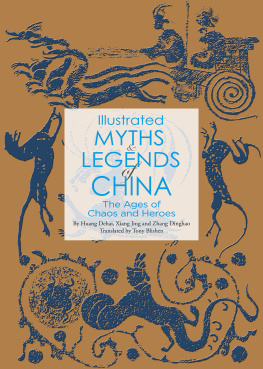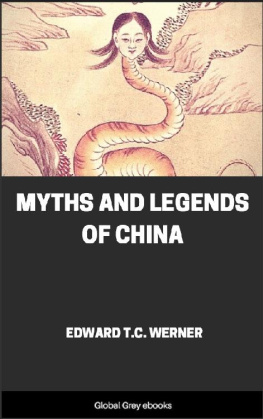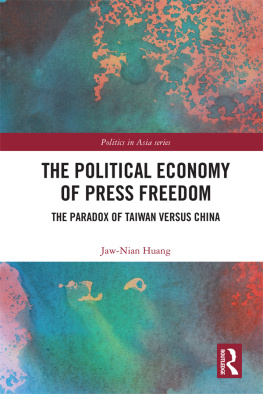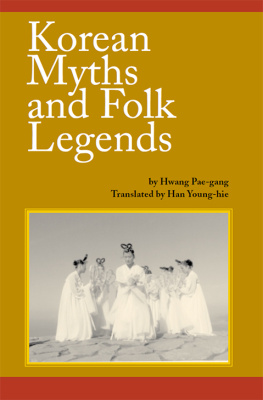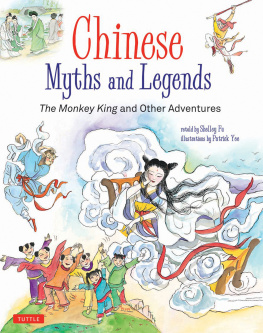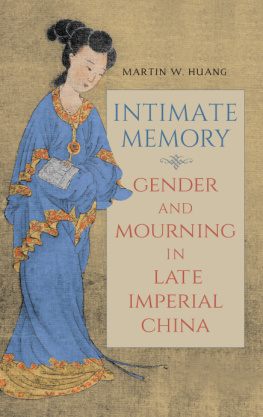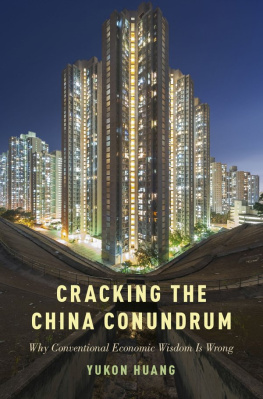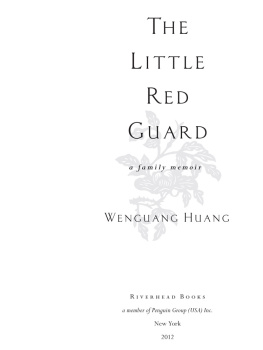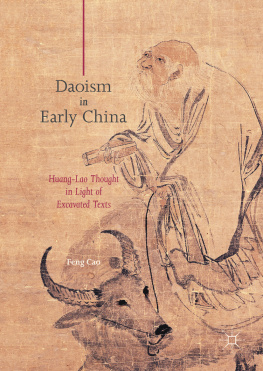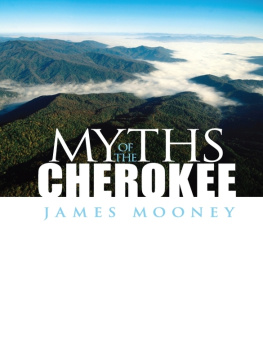Huang Dehai - Illustrated Myths & Legends of China
Here you can read online Huang Dehai - Illustrated Myths & Legends of China full text of the book (entire story) in english for free. Download pdf and epub, get meaning, cover and reviews about this ebook. publisher: Tuttle Publishing, genre: Religion. Description of the work, (preface) as well as reviews are available. Best literature library LitArk.com created for fans of good reading and offers a wide selection of genres:
Romance novel
Science fiction
Adventure
Detective
Science
History
Home and family
Prose
Art
Politics
Computer
Non-fiction
Religion
Business
Children
Humor
Choose a favorite category and find really read worthwhile books. Enjoy immersion in the world of imagination, feel the emotions of the characters or learn something new for yourself, make an fascinating discovery.
- Book:Illustrated Myths & Legends of China
- Author:
- Publisher:Tuttle Publishing
- Genre:
- Rating:3 / 5
- Favourites:Add to favourites
- Your mark:
- 60
- 1
- 2
- 3
- 4
- 5
Illustrated Myths & Legends of China: summary, description and annotation
We offer to read an annotation, description, summary or preface (depends on what the author of the book "Illustrated Myths & Legends of China" wrote himself). If you haven't found the necessary information about the book — write in the comments, we will try to find it.
Illustrated Myths & Legends of China — read online for free the complete book (whole text) full work
Below is the text of the book, divided by pages. System saving the place of the last page read, allows you to conveniently read the book "Illustrated Myths & Legends of China" online for free, without having to search again every time where you left off. Put a bookmark, and you can go to the page where you finished reading at any time.
Font size:
Interval:
Bookmark:
Illustrated
MYTHS AND LEGENDS OF CHINA
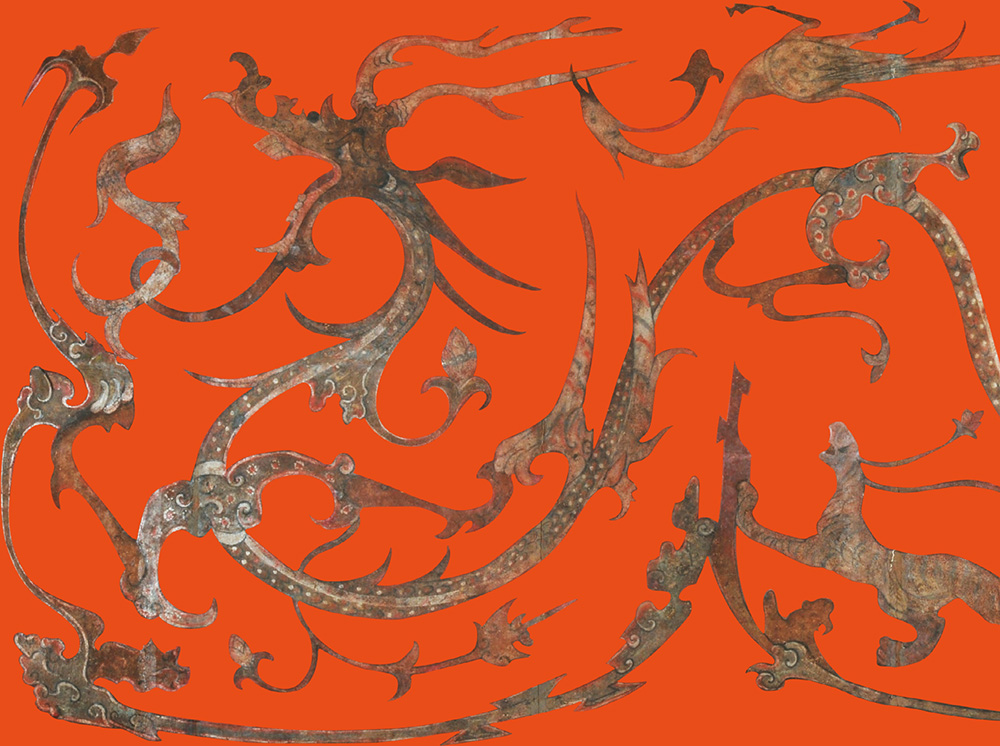
Mural: Four Spirits in the Cloud (detail)
See .
Illustrated
MYTHS AND LEGENDS OF CHINA
The Ages of Chaos and Heroes
By Huang Dehai, Xiang Jing and Zhang Dinghao
Translated by Tony Blishen
Better Link Press
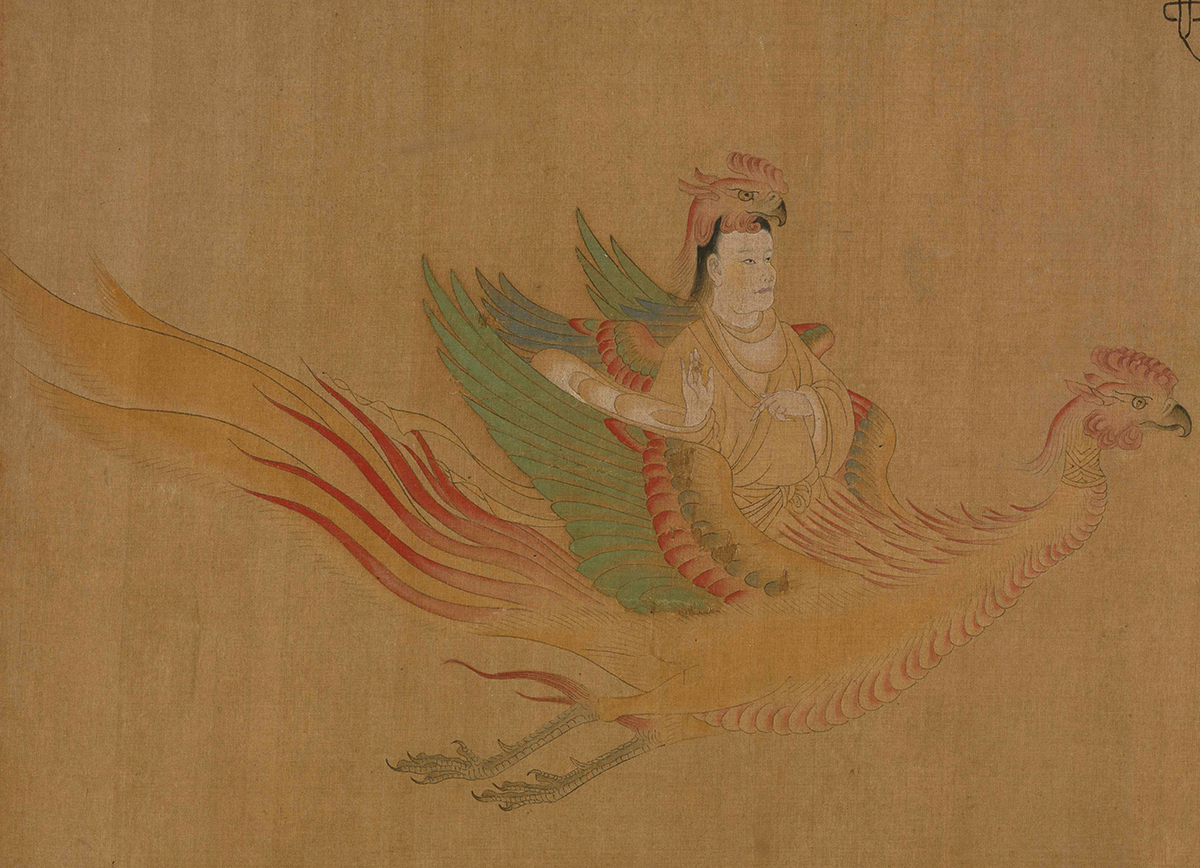
Handscroll: Gods of the Five Planets and 28 Stellar Mansions (detail)
See pages .
Copyright 2018 Shanghai Press and Publishing Development Co., Ltd.
All rights reserved. Unauthorized reproduction, in any manner, is prohibited.
This book is edited and designed by the Editorial Committee of Cultural China series.
Text: Huang Dehai, Xiang Jing, Zhang Dinghao
Translation: Tony Blishen
Interior Design: Li Jing and Hu Bin (Yuan Yinchang Design Studio)
Cover Design: Wang Wei
Copy Editor: Diane Davies
Editor: Wu Yuezhou
Editorial Director: Zhang Yicong
Academic Consultants: Wu Yigong, Sun Yong, Shi Dawei, Zhao Changping
Senior Consultants: Sun Yong, Wu Ying, Yang Xinci
Managing Director and Publisher: Wang Youbu
ISBN: 978-1-60220-170-5
Address any comments about Illustrated Myths and Legends of China to:
Better Link Press
99 Park Ave
New York, NY 10016
USA
or
Shanghai Press and Publishing Development Co., Ltd.
F 7 Donghu Road, Shanghai, China (200031)
Email:
Printed in China by Shenzhen Donnelley Printing Co., Ltd.
3 5 7 9 10 8 6 4 2
Quanjing provides the images on .
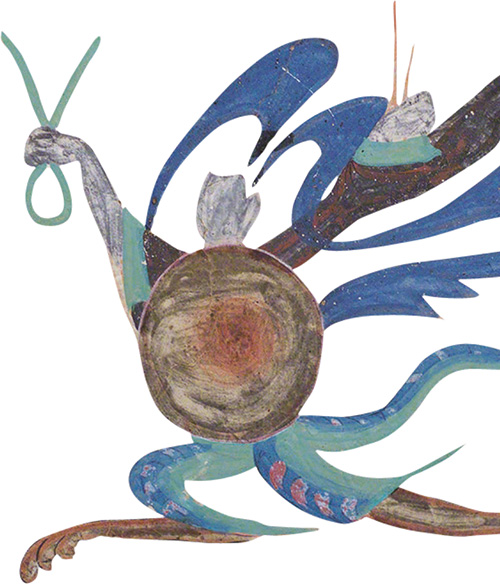
PREFACE
A DISTANT CONSCIOUSNESS
C hinese mythology has a multitude of arterial branches that have played a part in the education of both family and nation and turned a group of people dwelling with nature into a civilized community conscious of its own identity. The virtues and deeds of the heroic figures of legend such as Pangu, Nwa, Fuxi, Shennong the Flame Emperor and Yu the Great have been widely acclaimed. Their sense of morality courses unceasingly through the veins of the people, relaying an integrated spiritual model of the Chinese race.
Science has flourished but in the centuries that have elapsed since reason came to dominate the world, things that have remained despite all efforts to remove them, may have done so because they possess some particular strength. Myth and legend, for example, has not disappeared without trace from the modern world, but thrives and spreads in the fields of literature and art. Myth and legend is not a relic of the ancient past but a distant consciousness to which we are closely bound.
There is not a single unfamiliar story in Chinese mythology. These stories are concealed, latent in our living world in simple and definite forms, handed down by word of mouth, growing and multiplying. Our ancestors emerged from chaos, foraged for food in groups, sought out suitable places in which to live, pursued and fought and escaped from wild animals. From their settlements they cautiously crossed rivers, climbed the peaks of mountains and looked out on the four corners of the earth. They made their way through forests into the open spaces. They enjoyed the warmth of the sun, the sound of rain and water and experienced the cold chill of snow and ice. As time passed their limbs grew more adaptable and their minds quicker, encompassing love and hate. They developed from individuals into groups, to city-states and nations and to fresh wars and peace. Poverty gave way to wealth but once material needs were satisfied there remained the cultivation of mind and spirit as well as matters of good and evil, greed and desire and praise and punishment. Every aspect and corner of a culture was encapsulated in the form of a story.
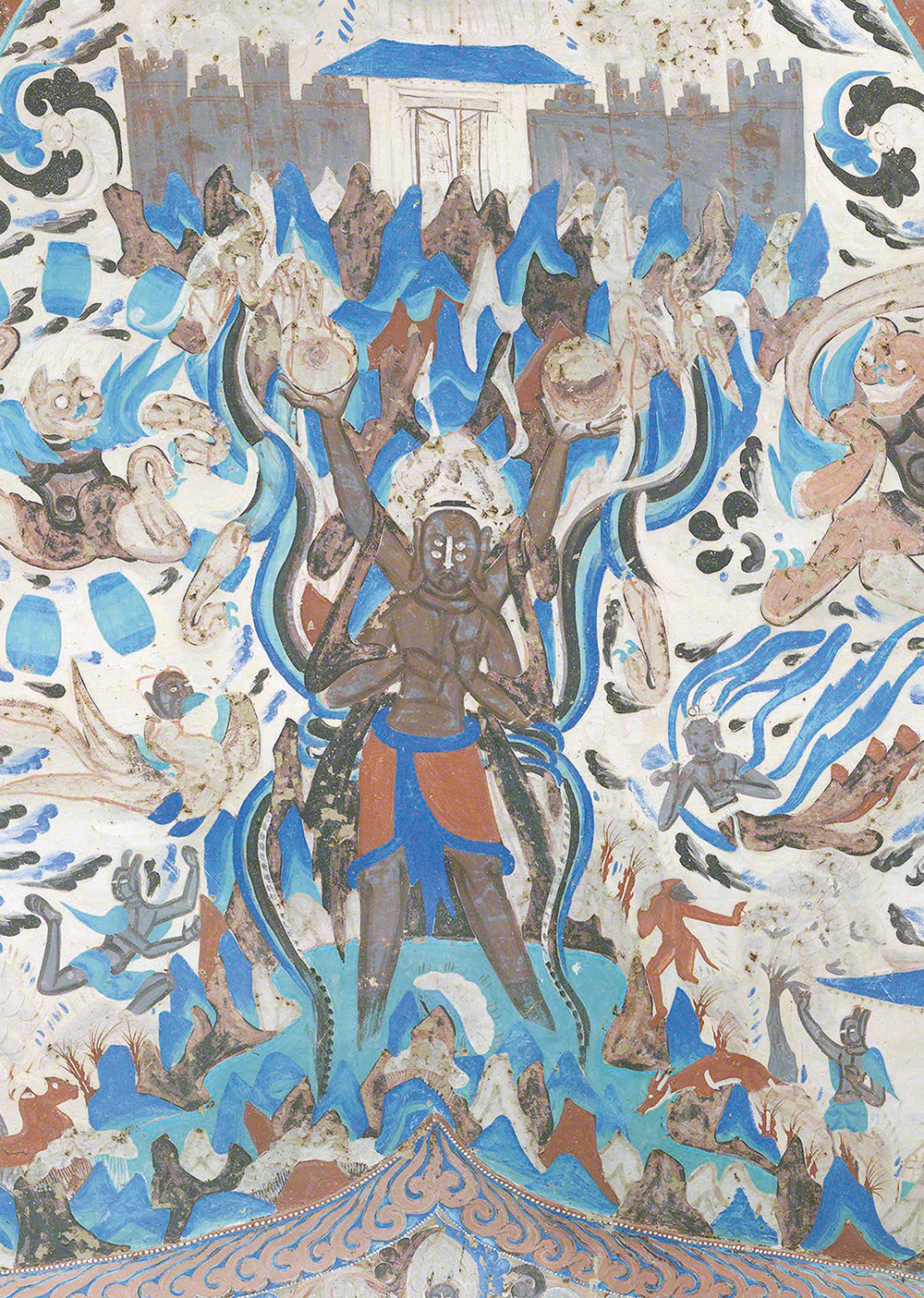
Mural from the West Slope of Mogao Cave No. 249 (detail)
Western Wei Dynasty (535556)
Dunhuang
Dunhuang Academy, Gansu Province
Fengbo and the Rain Master is the god of wind and rain in Chinese mythology. This mural shows King Asura in the center, with four eyes and four arms, standing in the ocean with hands raised, holding the sun and the moon with the sea beneath his feet. Painted above his head are the mountain Sumeru and the heavenly palace of Daoli with its door half open, half shut. Fengbo and Rain Master and others stand at the left of King Asura (see the detail on ). The whole has a sense of the interplay of thunder and lightning and the combination of wind with rain.
Each generation rewrote the original myths and legends on the basis of the vicissitudes of their own time, thus maintaining the vitality of the legends. The inner meaning of a myth lies in the process of birth and rebirth with its tendency towards a perfection of form that occurs continuously in the study of mythology. For instance, at a time when usurpation of authority was common in society, rewritten legends would somehow have something added to them. As an example, the more people were able to climb the Jianmu, Tree of the Ladder to Heaven and see the beauty of heaven and hear the stories of the gods, the more they were filled with envy, expecting that they, too, would one day become gods. But familiarity breeds contempt, they came to feel that there was nothing particularly special about the gods and gradually became presumptuous and disrespectful. Inevitably, this brought about the later punitive separation of earth from heaven. The retellings of later generations (and even the audacious rewriting) are part of the process of the constant re-creation of ancient legends. Through this process new meanings and forms are added and thus those seemingly remote myths always maintain their vigor.
The Greek gods of Olympus were not just waiting there to be excavated or dredged up, like a buried cultural object or a sunken ship. It was only with the poets Homer and Hesiod that the genealogy of the gods was established. Similarly, it was only through Virgil and Ovid that the Roman people learned of the sources of their own legends. We can conjecture that the western culture of Greek and Roman legend powerfully expresses the childhood of human society. Nevertheless, the understanding of early Chinese culture on the part of the western reader generally extends as far as Confucius and Laozi and no further. An analysis based on the co-ordinates of world culture suggests that the era of Confucius and Laozi equates with the period of the rise of Greek philosophy. The date of the death of Laozi is more or less that of the birth of Socrates and distant less than ten years from the passing of Confucius. In fact, the equal and opposite culture of China has a similarly rich mythological tradition that has nurtured the world imagination and sense of emotional well-being of generations. Through a combination of text and illustration this book seeks to present a succinct yet vivid description of these distant and ancient stories.

Searching the Mountains (detail)
Song Dynasty (9601279)
Anonymous
Ink and color on silk
Height 53.3 cm by length 533 cm
Palace Museum, Beijing
Next pageFont size:
Interval:
Bookmark:
Similar books «Illustrated Myths & Legends of China»
Look at similar books to Illustrated Myths & Legends of China. We have selected literature similar in name and meaning in the hope of providing readers with more options to find new, interesting, not yet read works.
Discussion, reviews of the book Illustrated Myths & Legends of China and just readers' own opinions. Leave your comments, write what you think about the work, its meaning or the main characters. Specify what exactly you liked and what you didn't like, and why you think so.

